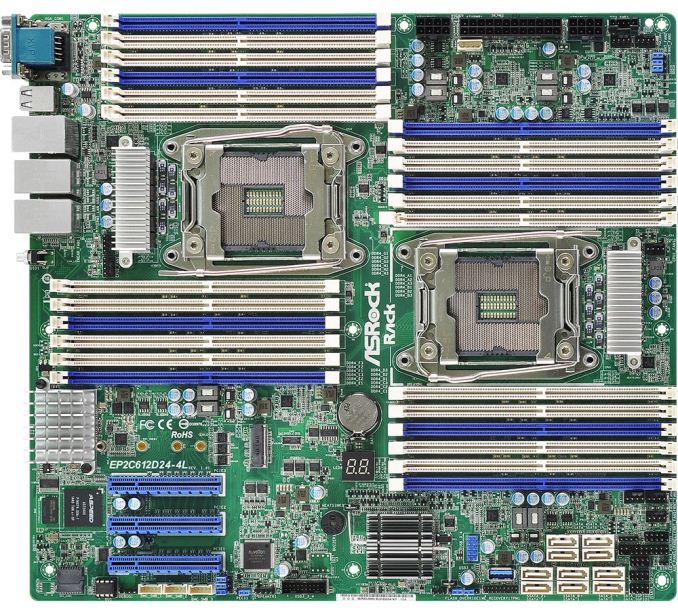ASRock Rack Announces EP2C612D24 and 4L: Dual Socket Haswell-EP with 24 DDR4 Slots
by Ian Cutress on May 23, 2015 8:10 AM EST- Posted in
- Motherboards
- Memory
- DDR4
- Enterprise
- DRAM
- Servers
- ASRock Rack
_678x452.jpg)
Two things jumped out at me when I received this press release. Firstly the name, which comes out as a mouthful – it isn’t something you could casually mention in conversation, even if you worked closely with the motherboard. The second is the amount of DRAM slots, which is ultimately what the EP2C612D24 and EP2C612D24-4L are catering for.
The Haswell-EP/Xeon E5 v3 DDR4 memory controllers are designed for up to three DIMMs per channel, similarly to Ivy Bridge-EP (E5 v2) and Sandy Bridge-EP (E5), although in all cases it is usually reserved for more niche systems. With 16GB UDIMMs, this allows for a maximum of 384GB, although moving up to RDIMM, LRDIMMs or 64GB NVDIMMs pushes the max to 1.5TB in a dual socket motherboard. Only those with deep pockets, big budgets or stringent requirements need apply, as the major cost here will be the DRAM.
The motherboard uses a staggered processor arrangement with narrow ILM versions of the LGA2011-3 socket. Combined with the 24 DRAM slots means there is little room for anything else. We get three PCIe 3.0 x8 slots which are open ended, allowing for x16 sized cards to come in, although one slot will be limited to reduced width cards as some of the DRAM slots would encroach a super long co-processor. The ten onboard SATA ports are supported by an M.2 PCIe 3.0 x4 slot and an onboard USB 3.0 Type-A port for in-chassis licensing dongles or Live-USB OSes. One downside to mention, according to the specifications for Haswell-EP, is that when fully populated, the memory should reduce down in speed, from 2133 to 1600 MHz.
Network connectivity is provided by an Intel i350 which gives four gigabit ports on the 4L model, but only two on the regular SKU, but we also get another network port for the AST2400 which provides IPMI 2.0 network management. ASRock Rack is targeting the usual suspects when it comes to large DRAM packages – intensive compute tasks, big data analysis, Hadoop and cloud computing.
Source: ASRock




_thumb.jpg)
_thumb.jpg)
_thumb.jpg)
_thumb.jpg)








48 Comments
View All Comments
TheUnhandledException - Monday, May 25, 2015 - link
Sadly yes. As others have said VGA is fine for LCD panels. It also is the least common denominator. Take any server for the last 30 years and they all have a VGA port. That means almost all KVM switches use VGA ports. It would make a lot of sense for KVM switches to use display port but a display port KVM is kinda useless if it can't connect to 70% of your servers and nobody is going to drop in a display port video card in a server just to connect it to the KVM. Server could use DP connector but since the KVM probably uses VGA that would mean a dongle or having both DP and VGA neither of which is attractive.Thus the great chicken and egg scenario has continued for a decade and probably will for another one.
Still IPMI has made a physical video port pretty much redundant. If the problem can't be solved over IPMI then in many organizations the server is being pulled from the rack anyways. I will point out that having the VGA port hard wired to the back panel (I didn't see any front panel header) is annoying as shit and a sign of a less mature product.
Dug - Tuesday, May 26, 2015 - link
Yes. One of the main reasons is because of compatibility and the fact they still use screws to tighten the connection. When you have servers that slide in and out of the rack, you don't want a connection that will pop out with some tension on the cable like you would get from display port.sulphurlad - Saturday, May 23, 2015 - link
Looks like my Supermicro X9 Dual board I bought (3) years ago, but it's missing (4) 16x PCIe slots.wintermute000 - Saturday, May 23, 2015 - link
Whats the Vmware compatibility of this thing? Don't forget us home white-box server tinkererssulphurlad - Sunday, May 24, 2015 - link
Probably fine, it's an Intel c612 chipset, might even be certified, it has an internal USB A connection, for installing onto a usb thumb drive.SanX - Sunday, May 24, 2015 - link
Make dual socket mobos with regular PC processorsbiostud - Monday, May 25, 2015 - link
I don't know much about these types of motherboards but wouldn't a 10Gbit network connection be a good idea?Dug - Tuesday, May 26, 2015 - link
Yes